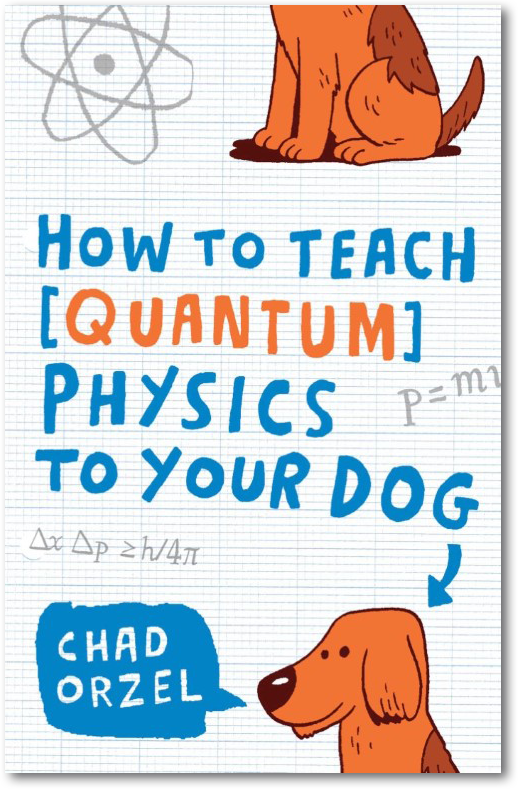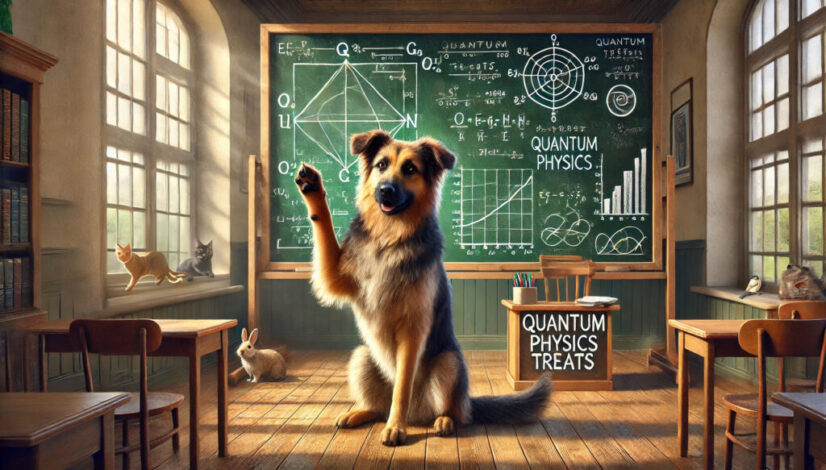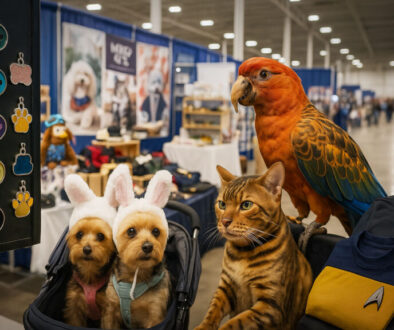“HOW TO TEACH QUANTUM PHYSICS TO YOUR DOG” – by Chad Orzel
Book Report: "How to Teach Quantum Physics to your Dog" Exploring the Mysteries of Quantum Physics Through Humour, Curiosity, and the Eyes of a German Shepherd named Emmy.
As the Director of STARFLEET Petfleet, I’ve seen firsthand how curiosity and exploration drive every great mission—whether it’s across the galaxy or into the quantum realm. Chad Orzel’s “How to Teach Quantum Physics to Your Dog” brilliantly combines science and humour by tackling the mysteries of quantum mechanics with Emmy, his German shepherd mix who’s as clever as any STARFLEET cadet. With Emmy as our guide, this book makes the strange world of particles, waves, and entanglement feel less like a daunting science lecture and more like an exciting away mission briefing.
Through Emmy’s practical (and treat-focused) questions, like—Can tunnelling help me catch bunnies and why can’t I bark entangled particles into submission?—Orzel explains key quantum concepts like particle-wave duality, Schrödinger’s cat, and quantum teleportation. Emmy’s antics bring a lighthearted perspective that aligns with STARFLEET’s spirit of curiosity and innovation. Each chapter is like a holodeck simulation, exploring the boundaries of reality while reminding us of the joy in discovery.
Orzel doesn’t stop at theory—he shows how quantum mechanics underpins technologies like lasers and semiconductors, bringing STARFLEET-worthy relevance to the science. Along the way, he boldly debunks pseudoscience, ensuring we navigate these concepts with integrity and logic. By the end, you’ll not only grasp quantum physics more clearly but also appreciate the boundless curiosity that drives all explorers—furry or otherwise. Whether you’re a quantum rookie or a seasoned officer, this book will inspire your next great mission into the unknown.
Chapter Summaries:
 Chapter 1: Particle-Wave Duality
Chapter 1: Particle-Wave Duality
Emmy’s idea of going around both sides of a pond to catch a bunny sparks Orzel’s explanation of particle-wave duality. In the quantum world, particles like electrons can act like waves, moving through two paths at once. Unfortunately for Emmy, her wavelength is far too small to make this strategy work. Her response? “So, you’re saying I need to lose weight?”
Chapter 2: The Heisenberg Uncertainty Principle
When Emmy loses her bone, Orzel jokes that he knows its velocity but not its position—a classic nod to the uncertainty principle. This principle states that you can’t simultaneously know both the exact position and momentum of a particle. Emmy isn’t impressed, accusing Orzel of making her bone disappear with “science magic.”
Chapter 3: Schrödinger’s Dog
Move over, Schrödinger’s cat! Emmy becomes the star of the Copenhagen interpretation. Orzel explains quantum superposition using a thought experiment: a box with a treat that’s both delicious and rotten until observed. Emmy, ever the pragmatist, decides the box should always contain treats. She isn’t one for philosophical ambiguity.
Chapter 4: Many-Worlds Interpretation
What if every decision creates a new universe? Orzel introduces the Many-Worlds Interpretation, where Emmy imagines a world where she catches every bunny she chases. While this theory is mind-blowing, Emmy prefers a single reality with infinite treats.
Chapter 5: The Quantum Zeno Effect
“Are we there yet?” Emmy’s impatience parallels the Quantum Zeno Effect, where constant observation prevents change. Orzel explains that if you keep measuring a quantum system, you can effectively freeze it. Emmy learns that staring at the treat jar doesn’t make the treats appear faster.
Chapter 6: Quantum Tunnelling
Emmy’s curiosity about digging through the neighbour’s fence leads to a discussion on quantum tunnelling. Orzel explains how particles can pass through barriers they shouldn’t, thanks to their wave nature. Emmy’s verdict? “That’s cool, but I’ll stick to chewing my way through.”
Chapter 7: Quantum Entanglement
“Spooky barking at a distance” is Emmy’s take on quantum entanglement, where particles remain connected regardless of distance. Orzel describes how measuring one particle affects the other instantly. Emmy wonders if this means she can bark in one spot and scare squirrels across the yard.
Chapter 8: Quantum Teleportation
Beam me a bunny! Emmy’s dream of quantum teleportation inspires Orzel’s explanation of transferring quantum states. While particles can teleport their quantum properties, entire dogs—and bunnies—remain firmly in place. Emmy is disappointed but still hopeful.
Chapter 9: Virtual Particles and Quantum Electrodynamics
Emmy learns that empty space isn’t really empty; it’s teeming with virtual particles popping in and out of existence. Orzel explains quantum electrodynamics, the study of how particles interact. Emmy concludes that if treats could spontaneously appear, the universe would be perfect.
Chapter 10: Misuses of Quantum Physics
Finally, Orzel tackles the pseudoscientific misuses of quantum physics, from “quantum healing” to dubious marketing claims. Emmy helps debunk myths by pointing out that if these claims were true, she’d already be teleporting treats into her mouth.
As the Director of STARFLEET Petfleet, I’ve read my share of books that inspire exploration and curiosity, but “How to Teach Quantum Physics to Your Dog” felt like Chad Orzel’s blend of humour, science, and Emmy’s treat-fuelled antics brought quantum mechanics to life in a way I never thought possible. It’s not every day you find a book that combines the wonders of modern physics with the relatable perspective of a German shepherd mix who just wants to catch bunnies.
What really resonated with me was Emmy’s boundless curiosity, which mirrors the core of STARFLEET’s mission to explore the unknown. Through her practical questions—whether about tunnelling through fences or teleporting treats—Orzel connects complex quantum principles to everyday wonder. The book reminded me that science doesn’t have to be intimidating; it can be fun, approachable, and even a little humorous at times. Much like STARFLEET’s goal to boldly go, this book inspires a deeper appreciation for the universe and the furry companions who make the journey even more meaningful. If you’re curious about science or just love a good laugh, this book is worth adding to your personal library.



